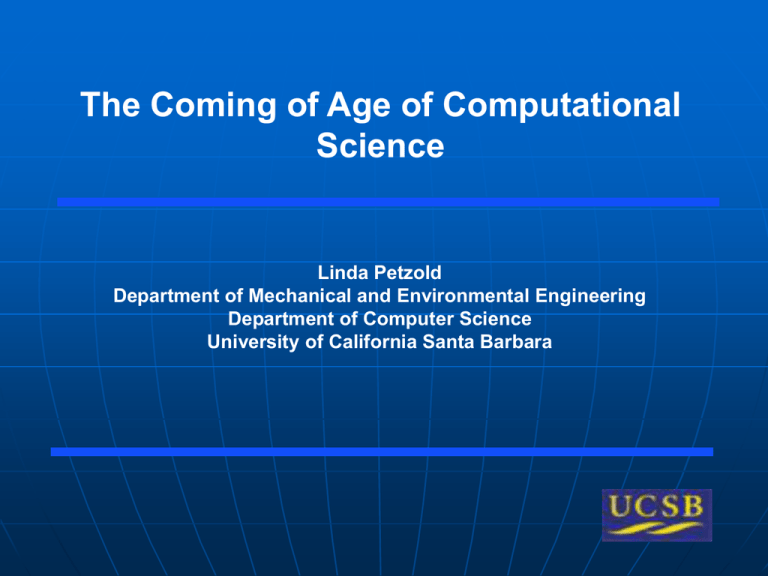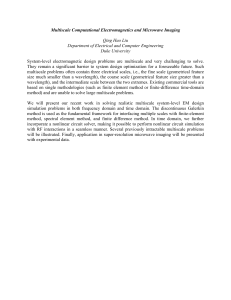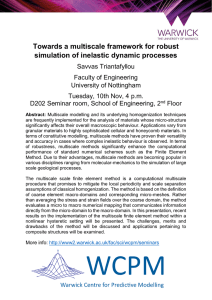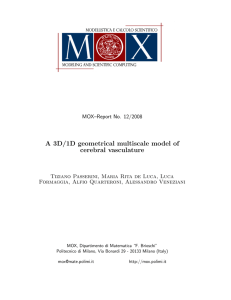The Coming of Age of Computational Science
advertisement

The Coming of Age of Computational Science Linda Petzold Department of Mechanical and Environmental Engineering Department of Computer Science University of California Santa Barbara Outline • The emerging discipline of computational science and engineering • The revolution at the microscale • Current trends and future directions Theory, Experiment and Computation Growth in the expectations for and applications of CSE methodology has been fueled by rapid and sustained advances over the past 30 years of computing power and algorithm speed and reliability, and the emergence of software tools for the development and integration of complex software systems and the visualization of results. In many areas of science and engineering, the boundary has been crossed where simulation, or simulation in combination with experiment is more effective (in some combination of time/cost/accuracy) than experiment alone for real needs. In addition, simulation is now a key technology in industry. Growth of Capabilities of Hardware and Algorithms Updated version of chart appearing in “Grand Challenges: High performance computing and communications”, OSTP committee on physical, mathematical and Engineering Sciences, 1992. The Revolution at the Microscale • Behavior near walls and boundaries is critical • Large molecules moving through small spaces • Interaction with the macroscale world is still important The Multiscale World •Quasicontinuum method (Tadmor, Ortiz, Phillips, 1996) Links atomistic and continuum models through the finite element method. A separate atomistic structural relaxation calculation is required for each cell of the FEM mesh instead of using empirical constitutive information. Predicts observed mechanical properties of materials on the basis of their constituent defects •Hybrid finite element/molecular dynamics/quantum mechanics method (Abraham, Broughton, Bernstein, Kaxiras, 1999) Massively parallel, but designed for systems which involve a central defective region surrounded by a region which is only slightly perturbed from equililibrium Nakano et al. More Multiscale •Hybrid finite element/molecular dynamics/quantum mechanics algorithm (Nakano, Kalia and Vashista, 1999) •Adaptive mesh and algorithm refinement (Garcia, Bell, Crutchfield, Alder, 1999) Embeds a particle method (DSMC) within a continuum method at the finest level of an adaptive mesh refinement hierarchy – application to compressible fluid flow •Coarse stability and bifurcation analysis using time-steppers (Kevrekidis, Qian, Theodoropoulos, 2000) The “patch” method Nakano et al. This is only a small sample: There is a new journal devoted entirely to multiscale issues! Engineering Meets Biology Computational Challenges: •Multiscale simulation •Understanding and controlling highly nonlinear network behavior (140 pages to draw a diagram for network behavior of E. Coli) •Uncertainty in network structure •Large amounts of uncertain and heterogeneous data •Identification of feedback behavior •Simulation, analysis and control of hybrid systems •Experimental design Multiscale Simulation of Biochemical Networks In the heat-shock response in E. Coli, an estimated 2030 sigma-32 molecules per cell play a key role in sensing the folding state of the cell and in regulating the production of heat shock proteins. The system cannot be simulated at the fully stochastic level, due to 32 •Multiple time scales (stiffness) •The presence of exceedingly large numbers of molecules that must be accounted for in SSA Khammash et al. Beyond Simulation: Computational Analysis •Sensitivity analysis •Forward and adjoint methods – ODE/DAE/PDE; hybrid systems Multiscale, stochastic,… still to come •Uncertainty analysis •Polynomial chaos, deterministic systems with uncertain coefficients •Many other ideas – special issue in progress, SIAM SISC 32 •Design optimization/optimal control •Design of experiments – to what extent can you learn something from incomplete information?, where is the most predictive power? More Computational Analysis •Determination of nonlinear structure – multiscale, stochastic, hybrid •Bifurcation •Mixing •Long-time behavior •Invariant manifolds •Chaos •Control mechanisms – identifying feedback mechanisms 32 •Reduced/simplified models – deterministic, multiscale, stochastic, hybrid systems, identify the underlying structure and mechanism •Data analysis – revealing the interconnectedness, dealing with complications due to data uncertainties Computer Science will Play a Much Larger Role Pragmatic reasons: Significant help from software tools •Source-code generation •Automatic differentiation – enables greater accuracy and reliability (and saves work in writing derivative routines and especially in debugging!) in generation of Jacobian matrix •Fix the dumb things we have done in codes , like ‘if’ statements in functions that are supposed to be continuous •Thread-safety - identify and fix the problems so that the code is ready for parallel/grid computing 32 •User interfaces: by current standards in the rest of the computer world, user interfaces for scientific computing look like this: Some exceptions and coming developments: •Matlab •Semi-automatic generation of GUI (MAUI,JMPL), for big production codes and dusty decks •Component technologies (PETSC) Computer Science will Play a Much Larger Role The deeper reason: At the smaller scales, we are dealing with and manipulating large amounts of discrete, stochastic, Bayesian, Boolean information. These are the foundations of Computer Science. Bioinformatics is just the tip of the iceberg. 32


